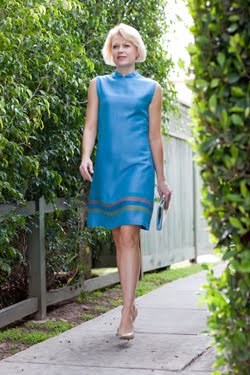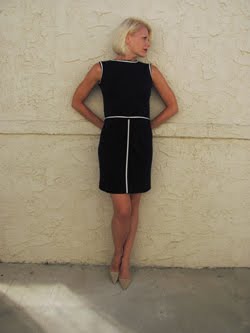I recently gave another presentation on iconic 1940s fashion in film, and every time I do this talk I declare 1946 to be the second greatest year in film history. Of course 1939 has long been regarded the best - completely justified with movie premieres that included Gone with the Wind, The Wizard of Oz, Mr. Smith Goes to Washington, The Women, Ninotchka, Stagecoach, and many many more. But 1946 is a year that's close to my heart and could be in contention for second place, particularly when you consider its style.
Years ago I decided to put together a list of 50 of the most influential costume design in the movies - I called it The Style Essentials. First I looked at iconic costume design in general. Then I narrowed the list to those films that impacted the way people dressed in the era they premiered - movies that have become historically and culturally relevant because they helped define what we now consider 1920s style, 1930s style, and so on. Finally, I narrowed the list even further and limited it to those costumes that continue to influence design today. When I analyzed the 1940s, I was amazed at the number that came from 1946 alone.
1946 was a banner year for film in general. With all the returning servicemen from World War II, it meant big numbers at the box office and classics like The Best Years of Our Lives, It's a Wonderful Life, My Darling Clementine, The Razor's Edge, and Duel in the Sun all came out that year. But we now can see that this was a year when film noir reigned supreme. It's amazing to me the number of greats from the genre that made their debut in 1946. What's even more amazing is how much their style has become so well known and important. Most fashion designers know these costumes very well and refer to them again and again in their work. And anyone who simply loves the glamour of fashion runways and red carpets also knows these costumes - including the look of the hair and makeup - even if they've never seen the movies.
The first three film noir below are included on my list of The Style Essentials. Interestingly, two of the three had costume designers who themselves had lives that sound straight out of film noir. More to the point, the ends of their lives sound straight out of film noir. Vera West, Univeral's head of costume design for two decades, died a suspicious death not long after she left the studio and started her own couturier. She tragically drowned in her pool and left notes behind that suggested she had been blackmailed for many years. Ruled a suicide, questions have entered the story since then such as her husband's behavior around the time of her death. On the other hand, there were no questions about the death of Irene, who was head of costume design at MGM. She checked into the Knickerbocker Hotel in Hollywood and leapt to her death from her 11th floor window. This was an extremely gifted woman with multiple boutiques and a tenure at the famed Bullocks Wilshire salon before she took the helm at MGM. Like West, Irene's life was filled with great success, but also with challenges she clearly could not overcome.
Putting these tragedies aside, it's the talent of these women and the other costume designers I want us to celebrate. The examples below are only a fraction of the incredible film style from 1946. To show some of their impact, I've also included examples of modern fashion and contemporary costume design relating to the three from The Style Essentials. Several are linked so you may read more about the movies or the designers and their body of work.
1946 is a year from the past that's very much a part of our present due to this costume design. If you admire the style, I strongly encourage you to watch these films and see all that they have to offer.
(above) The Postman Always Rings Twice at Hollywood's Egyptian Theater in 1946
One of The Style Essentials -
Gilda with costume design by Jean Louis
Some of the influence of Gilda on the red carpet -
Sandra Bullock in Alexander McQueen at the 2015 Oscars (above)
and Olivia Munn in Marchesa at the 2013 Oscars
Another of The Style Essentials -
The Killers with costume design by Vera West
Some of the influence of The Killers on the red carpet -
Mila Kunis in Christian Dior at the 2012 Golden Globes (above) and
Sofia Vergara in Donna Karan Atelier at the 2013 SAG Awards
The third of The Style Essentials from 1946 -
The Postman Always Rings Twice with costume design by Irene
Femmes fatale in neo-noir channel Lana's (almost) all white wardrobe of Postman -
Michelle Pfeiffer in 1983's Scarface (above)
and Kathleen Turner in 1980's Body Heat
Other influential film noir costume design from 1946 includes
The Big Sleep with costume design by Leah Rhodes
The Blue Dahlia with costume design by Edith Head
Notorious with costume design again by Edith Head
The Strange Love of Martha Ivers with costume design yet again by Edith Head
Humoresque with costume design by Adrian
The Stranger with costume design by Michael Woulfe (above)
and Deception with costume design by Orry-Kelly


































































































2 comments:
Orry-Kelly and Bette Davis - Problems Designing for Bette Davis
Bette Davis not like to wear a brasserie since it inhibited her or perhaps constricted when acting. The problem was that her bosom would make Miss Davis look very unfashionable (dumpy) but if the part required her to wear a brasserie should would in the film June Bride (Earner Bros, 1948) she portrays a fashion editor and her wardrobe was by Edith Head she consented to wear one. But when she did not wear a brasserie Orry-Kelly would create very elaborate neck designs on her costumes to draw the eye away from her bosom.
Great selections of costumes and fashions Kimberly! These femmes fatales (and heroines) from 1946 looked like dynamos and sirens. Thanks for this great year of the movies.
Post a Comment